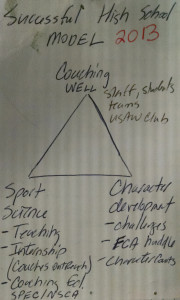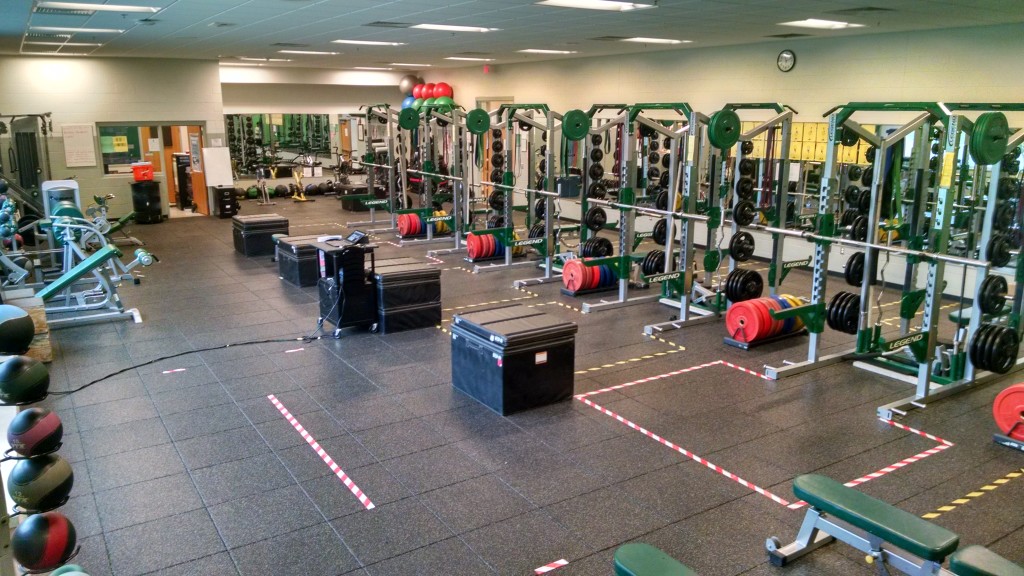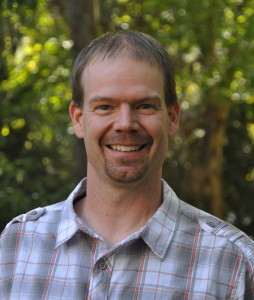Trends in High School Strength and Conditioning
Listen to a podcast of this article using this link:
“A Model Materialized: One Coach’s Perspective of How to Change the Paradigm of High School Strength and Conditioning” #HSS&CCP
Note: This research article was originally written June 2013 and updated multiple times over the last 2 ½ years with this last time being January 2nd 2016.
About three years ago a veteran coach Vern Gambetta came to North Carolina State University to advise some of the sport teams I was training. As he presented I began to reflect on the recent trends in the area of High School Strength and Conditioning and what I was learning from my incoming freshman. Coach Gambetta has been around for 40-50 years and helped build the profession to what it is from high school, college, and professional sports but he also capitalizes on where the profession is going (Reference 1). During his visit Coach Gambetta said, “because of the decline in physical education programs at the high school level young athletes are not exposed to the general fitness of strength and conditioning that is required to succeed in sports.” You will find from Coach Gambetta’s biography that he has worked with many sports at different levels including high school, college, and professional with teams like the San Francisco 49rs, Kansas City Chiefs, and the Chicago Bulls.
As a college strength coach for 9 years I saw the same trends in student-athletes entering their freshman year in college. Many of the high school athletes I now get to train are highly skilled but have a greater deficit of basic strength (squats, push-ups, and pull-ups) and power (squat jumps and clap push-ups) that is required to be successful in team sports. In past years, the Presidential Fitness program has been utilized by physical education programs to increase the standard of fitness among young adolescents (Reference 2). Sadly these standards have generally been done away with due to the fading economy from 2008-2012.
In this article I will present the idea that young student-athletes are not physically prepared for the demands of their sport because of the lack of adequate physical fitness standards, they have limited access to a qualified strength coach, and schools need a paradigm shift to implement a successful model for youth development.
The Presidential Fitness program provided quality standards which were the norm in the 1980’s-1990’s but are out of reach for many adolescents today. These tests included sit-ups, “curl ups”, shuttle run, “10 yd X 3 sprint”, one mile run, pull-ups, push-ups, and sit & reach test. (Reference 3).
Is it possible these days for a 15-year old girl to achieve the 50th percentile by doing 36 sit-ups, a 10 second shuttle run, 9:58 mile run, 1 pull-up, 15 push-ups, and a 8+ inch sit-and-reach? Maybe…how about 85th percentile 48, 11, 8:08, 2, 20, and 4? Not many…OK so how about a 15-year old boy’s standards at the 50th percentile? 45 curl-ups, 9.7 shuttle run, 7:30 mile, 6 pull-ups, 30 push-ups, and 2+ inches reach? Maybe…but how about 85th percentile: 57, 9.0, 6:20, 12, 42, and 2+ inch reach? I’m convinced not very many could attain to these standards.
Could there be a link between the drop in these physical standards and the level of competition and higher injury rates? Dr. Dawn Comstock has charted the growing trends in high school participation along with increased injury rates among high school student-athletes (Reference 4). A summary of the national collection of injury rates is simple: “Injury rates among high school athletes should be reduced to the lowest possible level without discouraging adolescents from engaging in this important form of physical activity.”
The lack of Physical Education’s programs:
Who has stepped up to meet the challenge of this expanse that has grown between young adolescents and the level of fitness for preparation in sport? There are a number of people trying to step up including the sport coach, private personal training facility, but the answer is a developmentally appropriate strength and conditioning program.
1) The first solution is to have an experienced professional on campus like the requirement for an athletic trainer
2) The second solution is to have this qualified coach registered through the National Strength and Conditioning Association with the (Certified Strength and Conditioning Specialist) or C.S.C.S
3) The last solution to meet the rising demands is for the program to have appropriately planned strength and conditioning standards to monitor progress
There should be a way to build a high school model for strength and conditioning that is done professionally but not commercially. For better or for worse, the gap seems to have narrowed in the similarities between high school and college athletics and this raises the standard on the physical education programs across America.
Piecing these issues together is the problem:
Colleges and high schools deal with different developmental levels of athletes. In high school, there is a lack of basic muscular strength, coordination and balance, and the skills level required to succeed at a particular sport. The National Federation of High Schools (NFHS) had a workshop in December 2009 to develop a curriculum to address the growing needs for high school athletes (Reference 5).
Many physical education programs like this do exist in the United States in school districts that have seen the need and worked to meet those needs. There remains many obstacles that must be overcome with funding, facilities, and qualified personnel. This NFHS workshop identified 32 academic courses offered in Texas in 2009. I spoke with a high school coaching friend of mine, Larry Meadors, who has been coaching for 50 years in Minnesota. Coach Meadors and I met in 2007 at the Coaches College at ETSU in Johnson City, TN.
He presented on the development of high school strength and conditioning (Reference 6). As we talked about the benefits and downfalls of this programming approach it made me think about the how many unqualified professionals are trying to address the needs presented by the gap between physical education and strength and conditioning. I have not researched this extensively but I have met enough coaches in high school strength and conditioning to confirm there is a need for higher qualified coaches. In February 2010, the National Strength and Conditioning Research Journal came out with a research study looking at the trends of strength and conditioning professionals (Reference 7). This profile of the high school strength and conditioning coach outlined a survey of 39 high school coaches from 24 states that responded. The most common states were Texas, California, Iowa, Florida, and Oklahoma.
In summary, the research study shows that the high school strength and conditioning profession is growing rapidly with better resources and longer coaching tenures. Most of these coaches were not on a teachers contract and made between $55-57,000 for a 12 month contract, worked an average of 9 hours day, and trained between 190-200 students in a 3000-4500 square foot facility. The top four advantages of the high school setting were pay benefits, job security/less pressure, watching kids grow up/mature, and developing young athletes. Compare this to a college strength and conditioning coach who generally makes between $41-47,000, works an average 12 hour day, trains as many athletes, and generally has a bigger square foot facility. The same advantages could be observed for college coaches minus the lower pay and more pressure to produce.
Building a model to change the paradigm:
The last few years I have been developing and implementing a model of training that I think addresses the main needs for the high school strength and conditioning program. The model centers on:
-
EFFECTIVENESS in Coaching staff, students, teams, and sports clubs.

-
EDUCATION for the athlete and coach (including volunteer assistant program/internship)
- CHARACTER DEVELOPMENT of leadership (see my original picture drawn on a 3X5 note card)
According to many coaches at a recent round-table, the use of effective sport science deals with: “sport performance enhancement (including creating better equipment) through the use of scientific methods” (Reference 8).
Over ten years I have attended the Coaches College annual conference at ETSU that focuses on this aspect of long term development (LTD)/ planning periodization. I have learned it is necessary to stay on top of the educational trends in this rapidly growing profession. This raises the level of quality of coaching for training larger numbers of young athletes. Secondly, the teaching and recruitment of volunteer assistants should be a strong consideration for those desiring to become certified strength & conditioning coaches. I have directed 40+ assistant coaches over the last 12 years, and their development has exponentially expanded the effectiveness of the methodology, program design, and implementation with each team and athlete in the program. Lastly, and most importantly for the program is to advance the character development of the coaches, assistants, and the athletes. In my experience, this is best advanced through Christian leadership principles that I’ve used from John Maxwell’s materials (Reference 9), which includes conversational scenarios in meetings, and personality assessments about how to lead effectively.
These three points of EFFECTIVENESS in Coaching, EDUCATION in Sports Science, AND CHARACTER DEVELOPMENT can build a strong strength and conditioning model and help change the paradigm. At Cardinal Gibbons we seek to build a program that can succeed with the right attitude, the right balance of resources, and an educational community that is bold in its support of students and staff in these three key areas of growth. Gibbons STRENGTH has a mission to: create a positive environment (coaching effectively) that is relational (educational to all) and gets results (good sports science)!
Now, I am privileged to see this model beginning to work effectively in the community with the Gibbons STRENGTH program. I’d like to take this model to other high schools in the future as I earn an opportunity to advise and speak.
Chris Morland, MS, CSCS
Director of Strength and Conditioning/Teacher
Educator and Coach | Visionary
Please leave your comments or e-mail what you liked or have questions about below and we will post them!
Would you follow Morland STRENGTH on our new Instagram account?
#dreammor #MorlandSTRENGTH
References
2. Presidential Challenge Program activities
3. Presidential Challenge Program standards
4. Center of Injury Rates and Policy
5. National Federation of High School Workshop: December 2009
8. National Strength and Conditioning Research Journal. April 2010. Sports Science. By G. Gregory Haff
9. John Maxwell Books. “Talent is Not Enough, The 21 Irrefutable Laws of Leadership, The 360* Leader, Putting your Dream to the Test, The 15 irrefutable laws of teamwork and growth.”



How would you say this model could be implemented in different sized high schools?
Creatively looking at the resources your school currently has currently is a start. We have found the most important resources to be the students, staff, and some open space. Forming a student leadership team of the committed students and encouraging the coaches to come in and workout with the teams is beneficial. I’d also say thinking about your training program with the open space you have is a great idea! I call this the “weightroom n the hallway” mentality which is the way I began my training career. Chris Morland, MS, CSCS
Way cool! Some very valid points! I appreciate you penning this article and also the rest of the website is really good. Maribeth Dion Goodhen